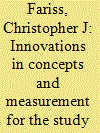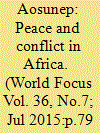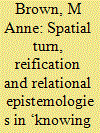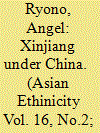| Srl | Item |
| 1 |
ID:
053737


|
|
|
| 2 |
ID:
057052


|
|
|
| 3 |
ID:
063811


|
|
|
| 4 |
ID:
176037


|
|
|
|
|
| Summary/Abstract |
The observation, measurement, and analysis of violent and contentious processes are essential parts of the scientific study of peace and conflict. However, concepts such as the level of repression, the number of individuals killed during a civil war, or the perception of members of an out-group, are often by definition difficult to observe directly. This is because governments, non-state groups, NGOs, international organizations, monitoring organizations, and other actors are not incentivized to make information about their actions systematically observable to analysts. In this context, latent variable models can play a valuable role by aggregating various behavioral indicators and signals together to help measure latent concepts of interest that would not otherwise be directly observable. Each of the articles in this special issue uses some form of a latent variable model or related measurement model to bring together observable pieces of information and estimate a set of values for the underlying theoretical concept of interest. Each of the articles pays special attention to the processes that make the observation of peace and conflict processes so challenging. As we highlight throughout this introductory article, the unifying framework we present in this special issue is validation. Though the substantive content of each of the articles in this special issue varies, they represent the diversity of substantive interests that span the study of peace and conflict, broadly conceived. Overall, we hope that the special issue becomes a standard reference for scholars interested in developing and validating new measurement models for the study of peace and conflict.
|
|
|
|
|
|
|
|
|
|
|
|
|
|
|
|
| 5 |
ID:
139362


|
|
|
|
|
| Summary/Abstract |
The state of peace and security poses several continuing challenges in the African continent, which has its roots in the history. Besides the steady progress of African Union’s (AU) achievements, the continent is still faced with certain incessant conflicts. While the efforts of AU and the regional organisations are appreciative, yet due to paucity of funds of many African countries including the AU itself, many a time faced with obligation of providing maximum thrust in performing their task.
|
|
|
|
|
|
|
|
|
|
|
|
|
|
|
|
| 6 |
ID:
064340


|
|
|
| 7 |
ID:
175359


|
|
|
|
|
| Summary/Abstract |
How we approach knowing conflict and security makes a difference. This article first considers how reification, instrumental subject/object relations and the drive for certainty and control undermine effective knowledge and practice in questions of conflict and peace. It then turns to what the spatial turn and notions of emplaced security might offer to working against violence. As with any theoretical perspective, the spatial turn can itself be reified, repeating epistemological relations entrenched in much security analysis. The spatial turn and emplaced security explicitly highlight alternative, more relational knowledge practices, however. A relational epistemology approaches knowledge not only as information about a subject out there, but also as a form of practice with others which changes conditions of possibility for co-existence. If pursued, such approaches could help loosen the grip of narrow constructions of security, insecurity, the person, power and agency which dominate security analysis and obstruct understanding and the generation of alternatives in situations of entrenched conflict. An orientation to place could not only enable more nuanced accounts of peace and conflict, but support mutual recognition and exchange across division, assisting an ethic of attention and concrete peace and conflict resolution efforts.
|
|
|
|
|
|
|
|
|
|
|
|
|
|
|
|
| 8 |
ID:
137225


|
|
|
|
|
| Summary/Abstract |
In 2009, a demonstration in Urumqi deteriorated into one of the bloodiest riots in contemporary Chinese history. Some scholars and media groups have responded to the event by focusing public attention on the bottom-up, ethnic, and social aspects of Xinjiang’s conflict phenomenon. This article raises questions and concerns about framing the 2009 event from an ethnic and social standpoint. The authors combine conflict studies with a longue durée historical analysis to argue that multiple dimensions and the intersections of these dimensions constitute the 2009 Urumqi uprising. Present conflict is placed against a backdrop of unequal Chinese state policies with Xinjiang. The authors then forward a Uyghur perspective underpinned by peace and conflict studies concepts. The conclusion recommends conflict prevention strategies by urging the Government of the People’s Republic of China to take ownership of the consequences of its policies and the broken contracts with Uyghur minorities in Xinjiang.
|
|
|
|
|
|
|
|
|
|
|
|
|
|
|
|